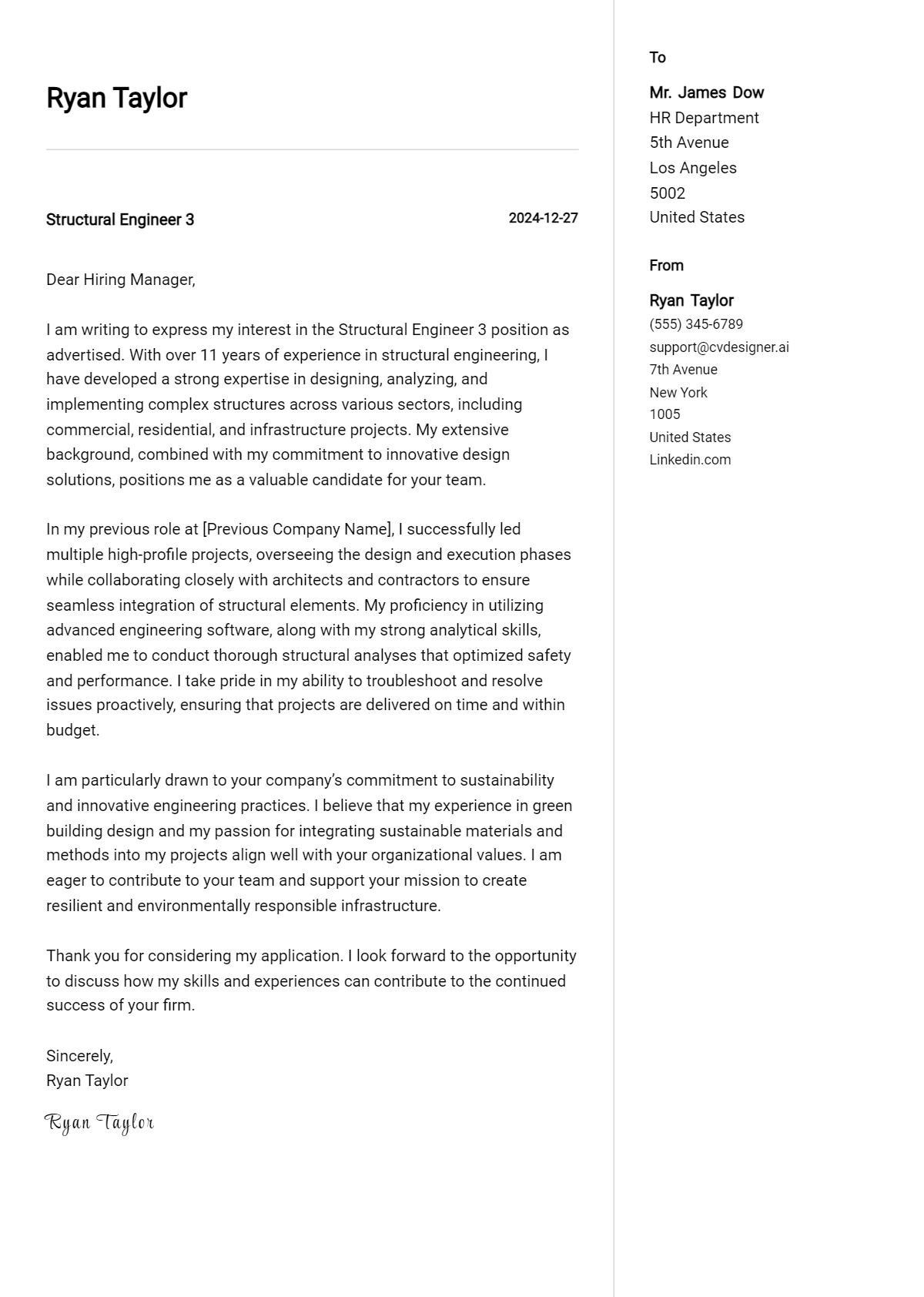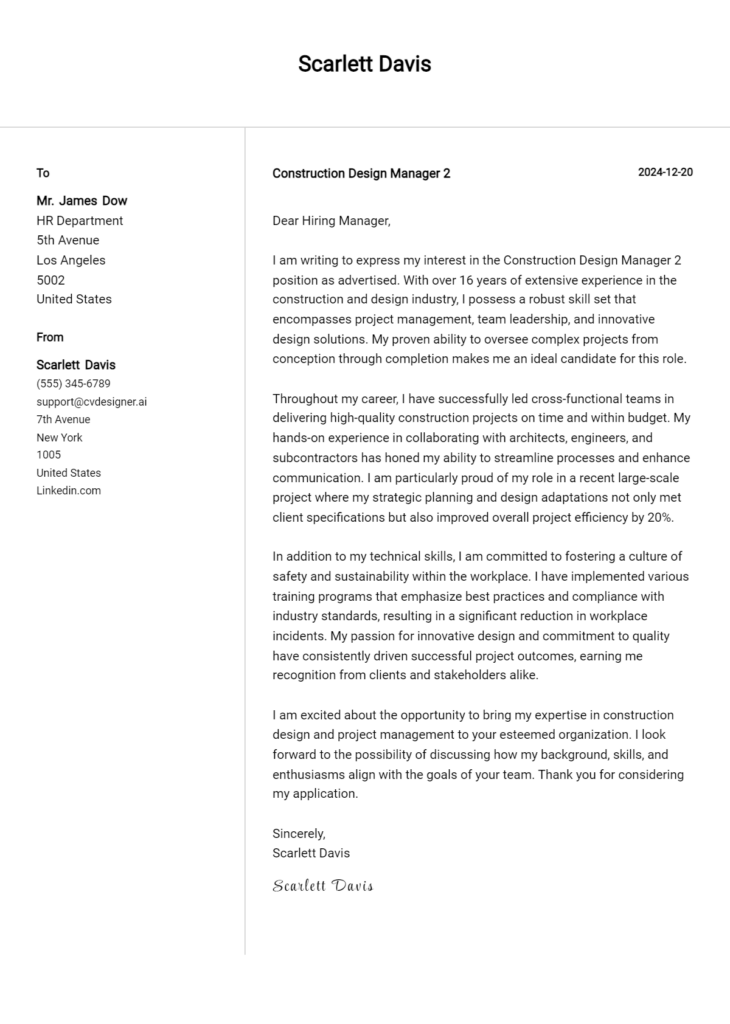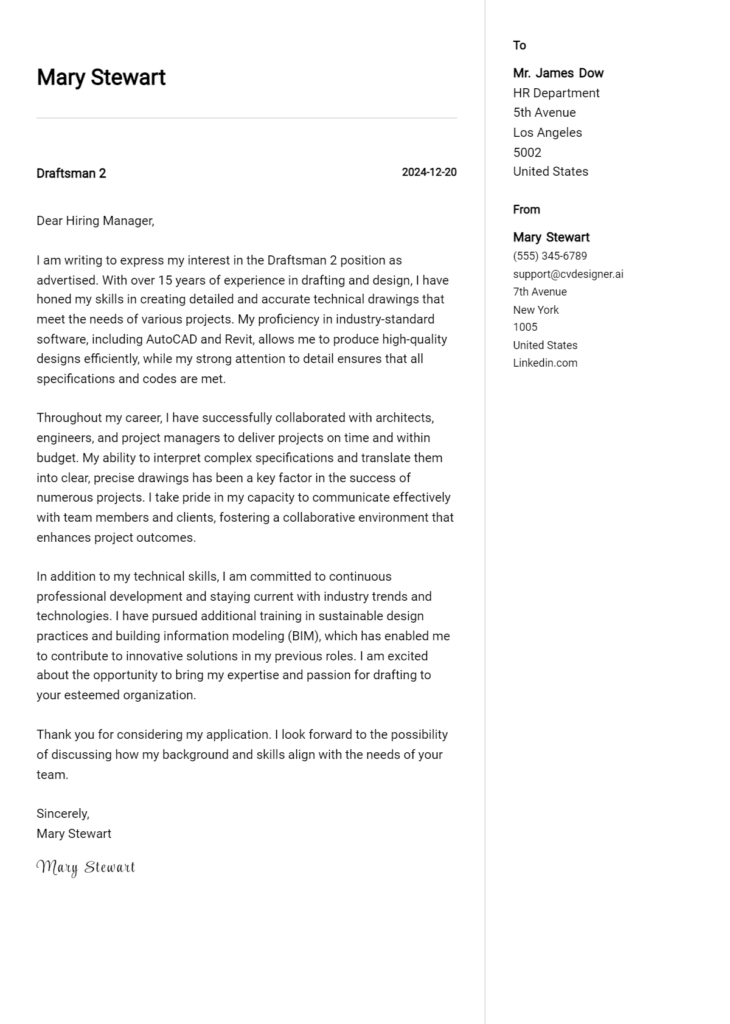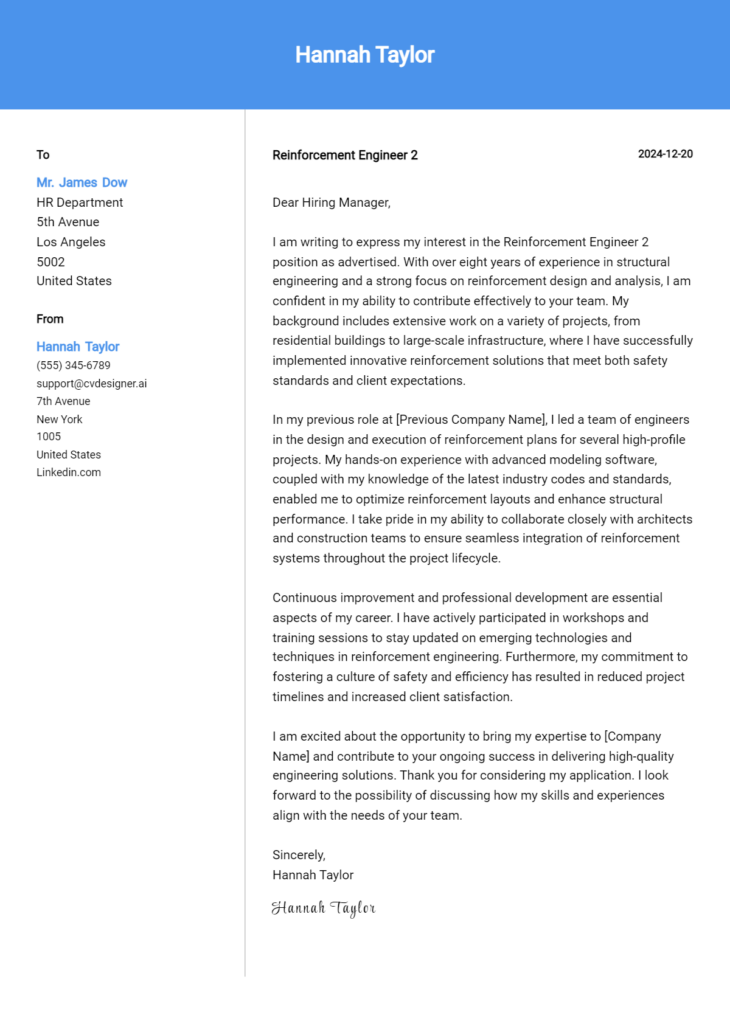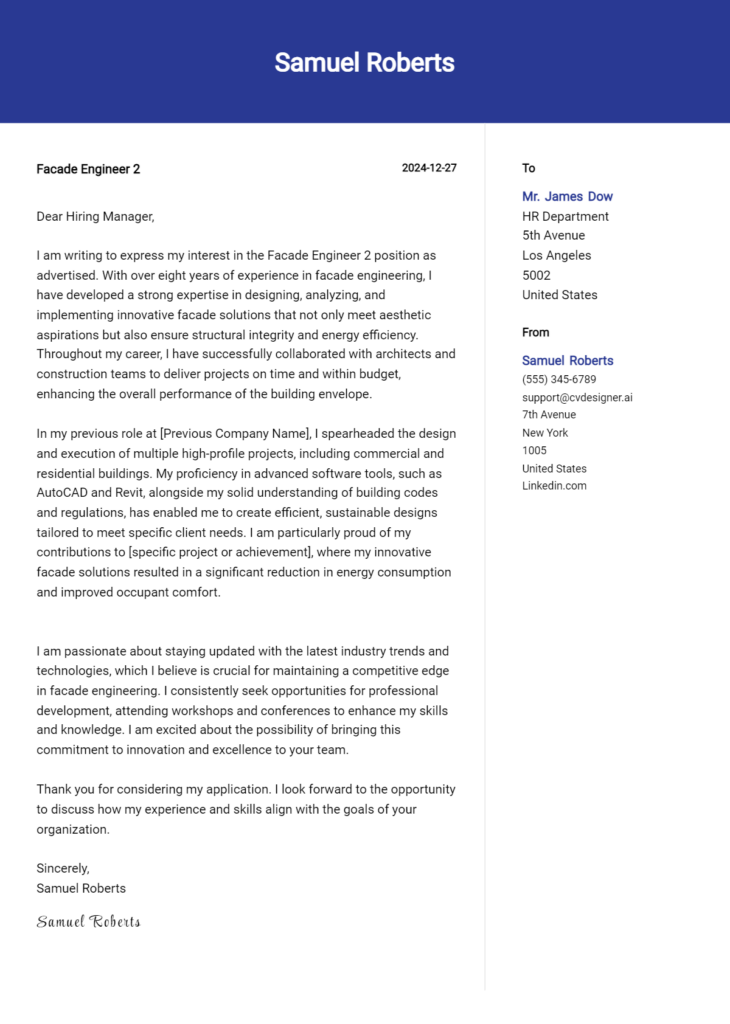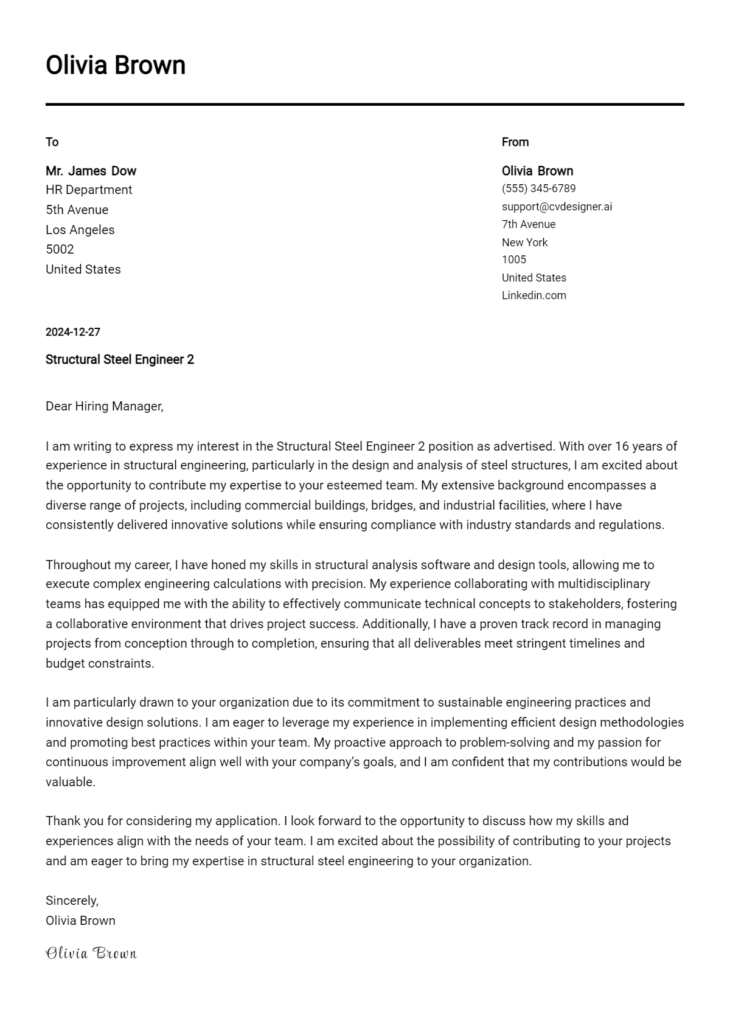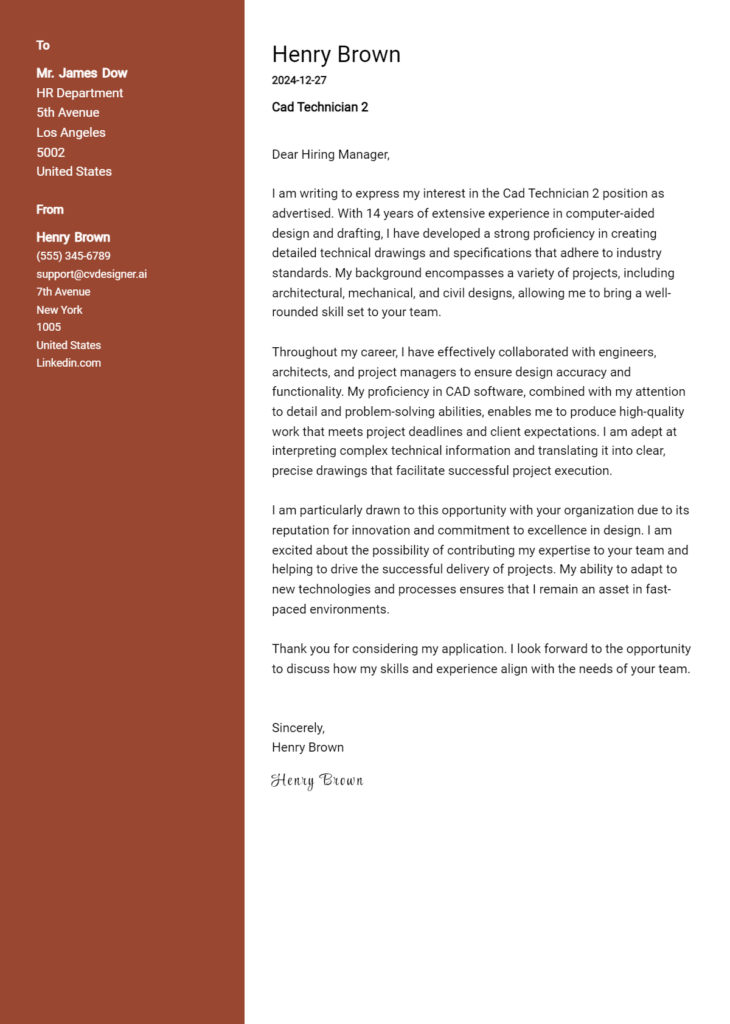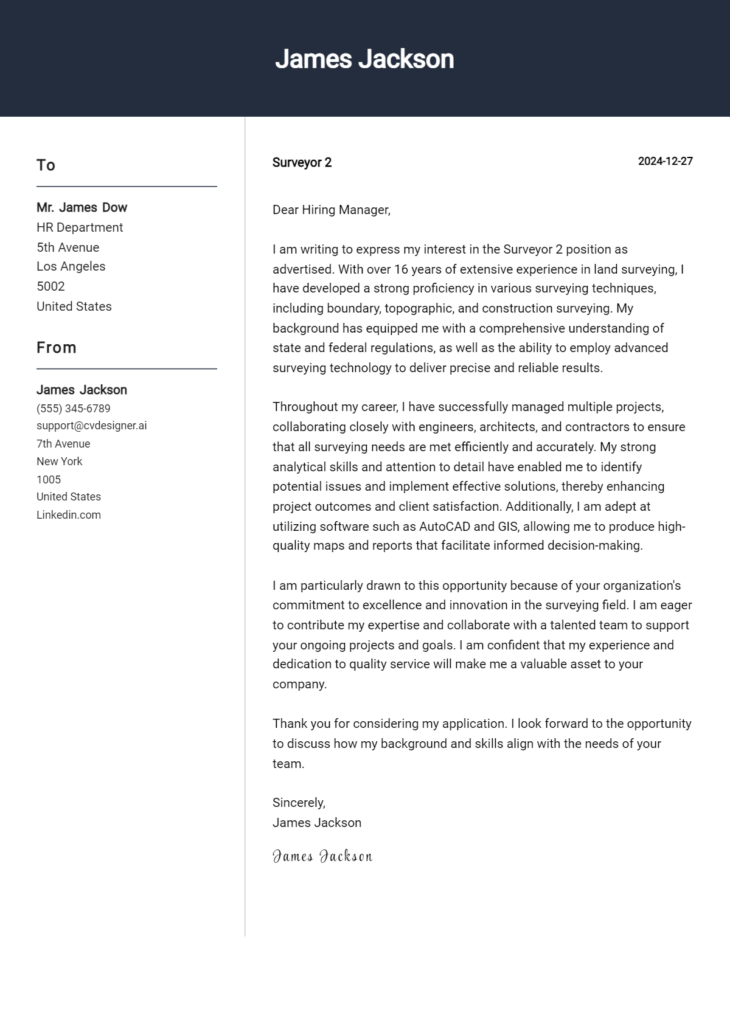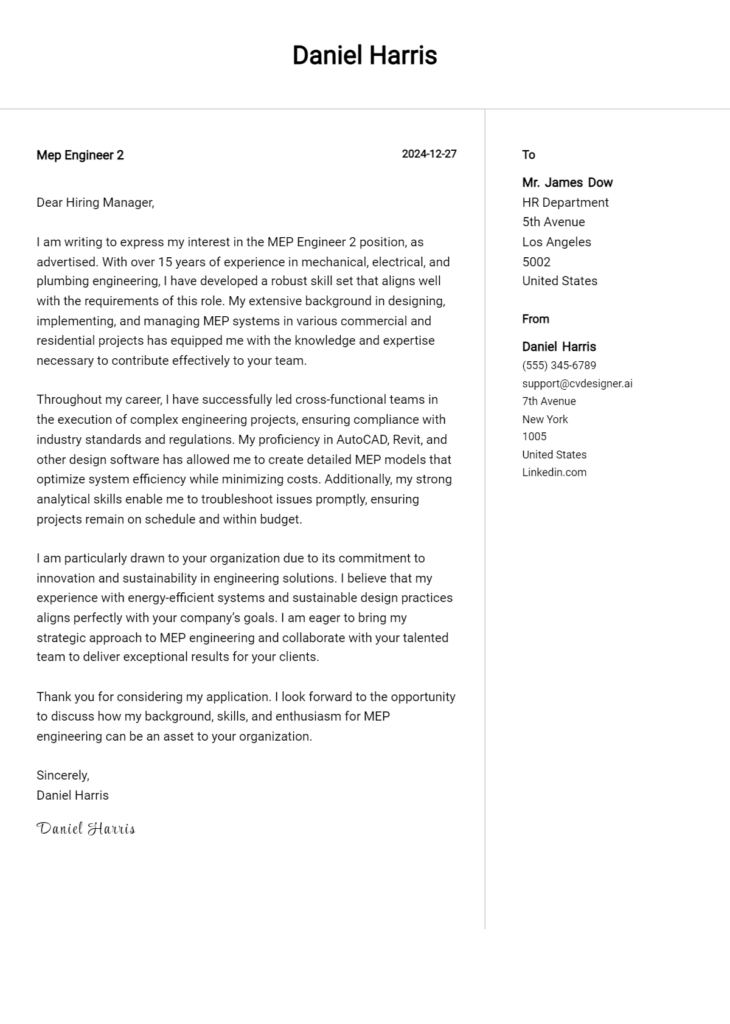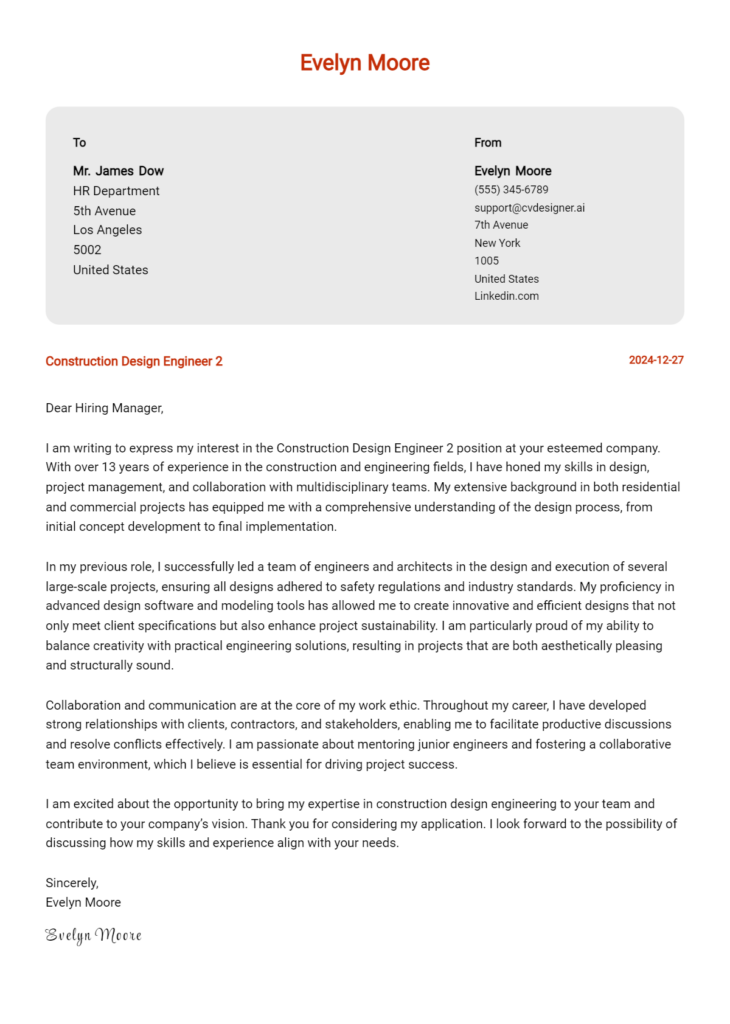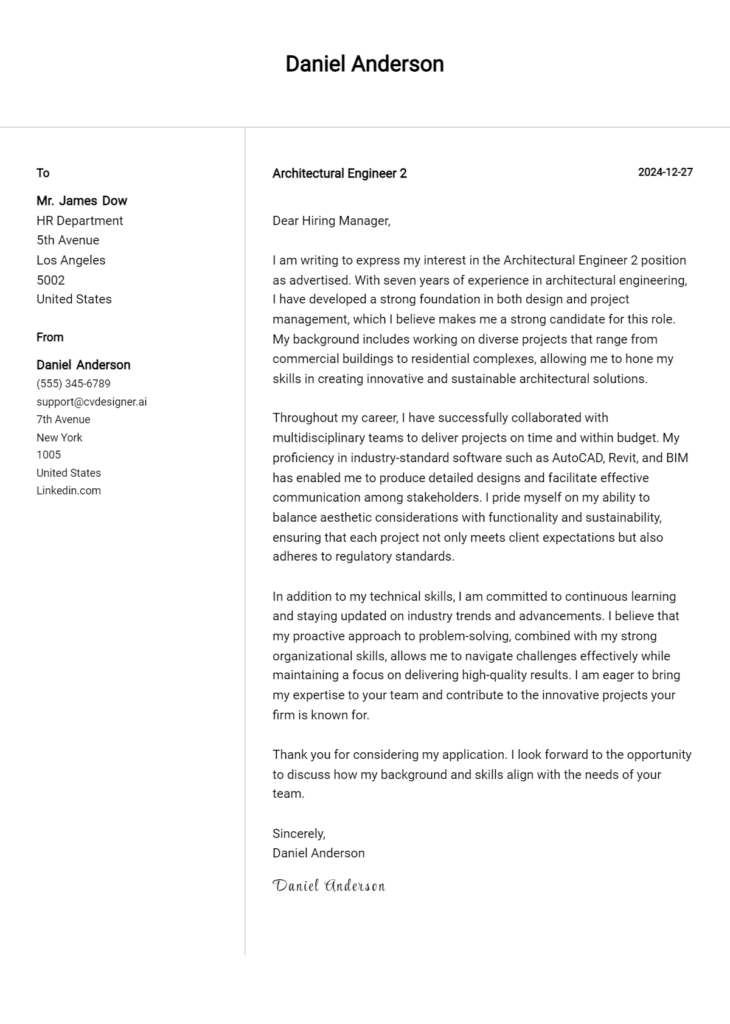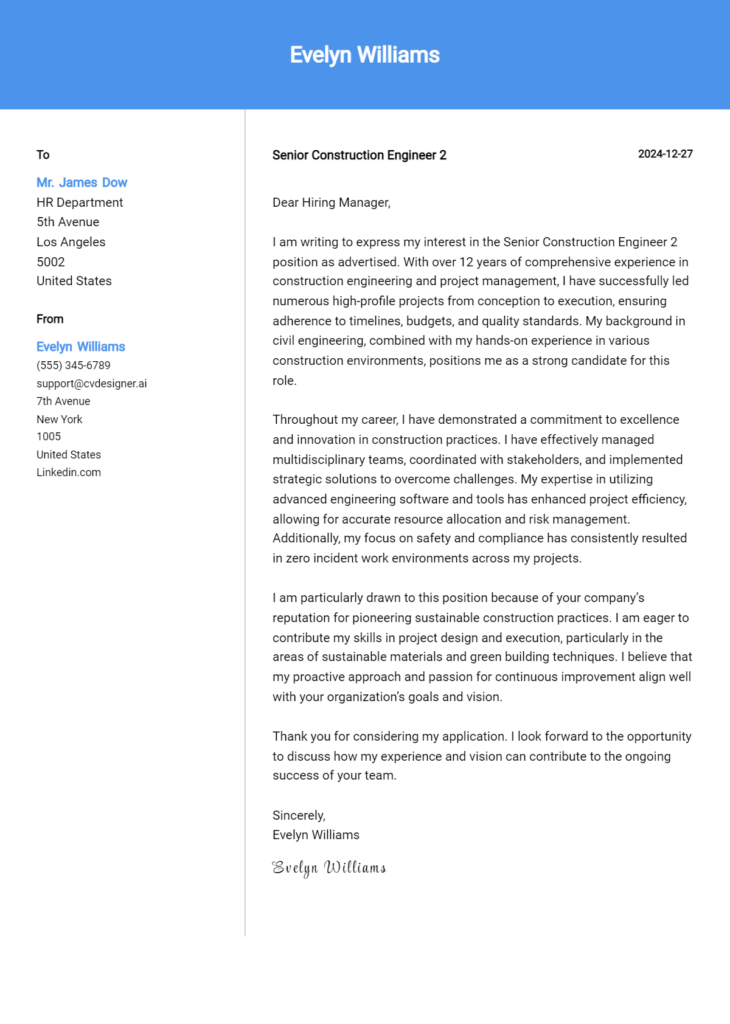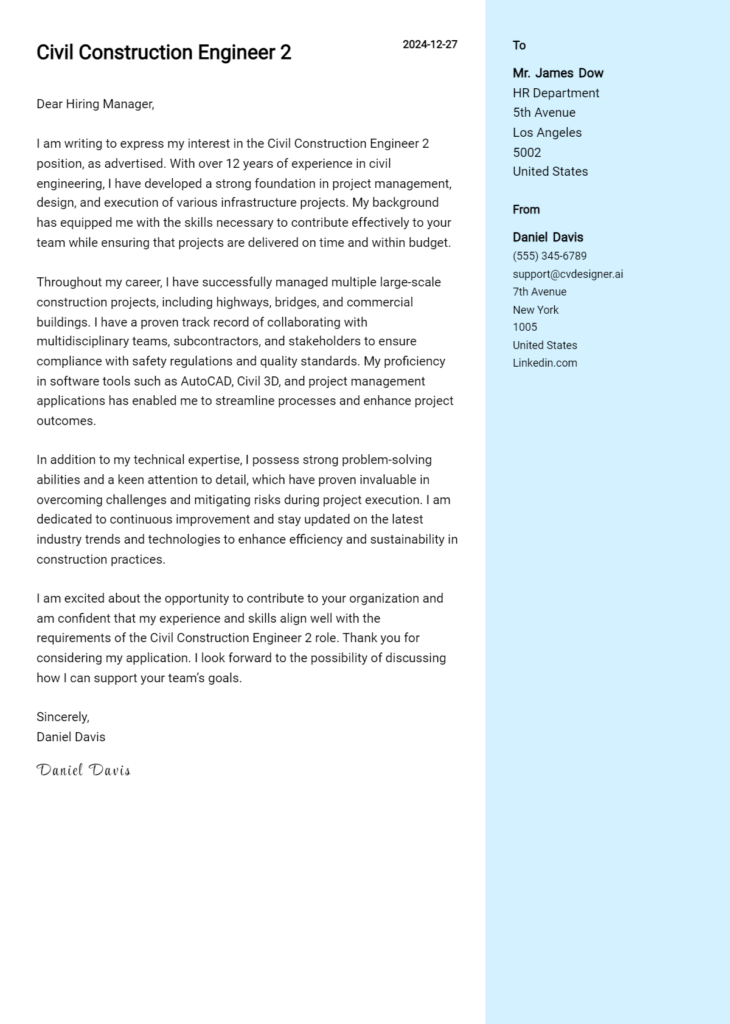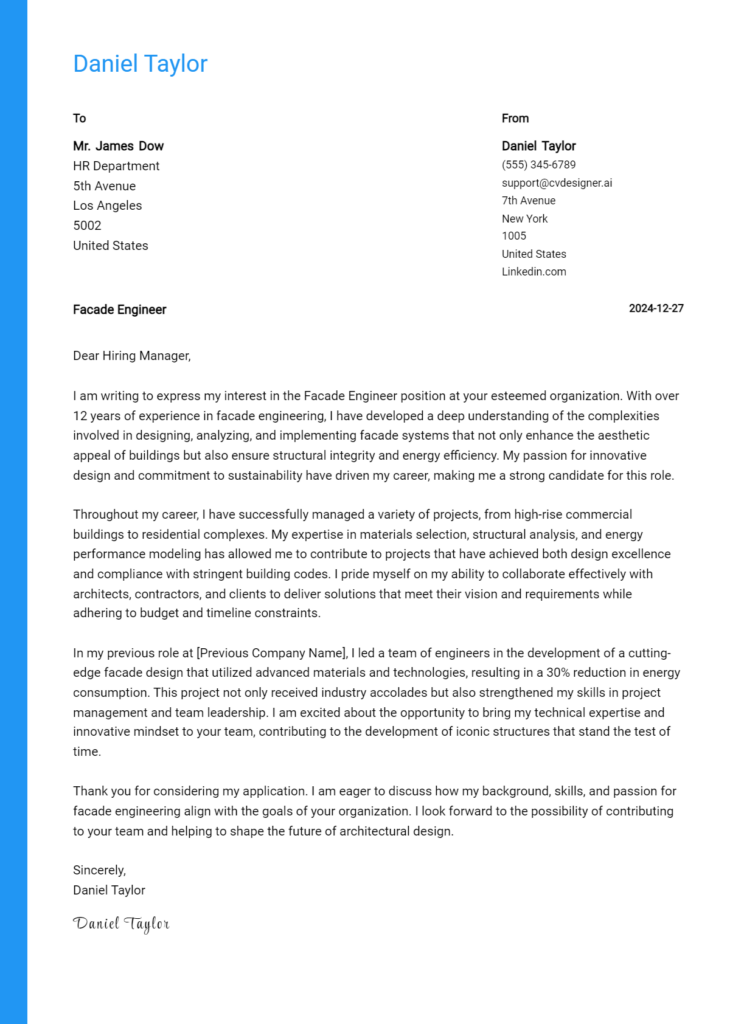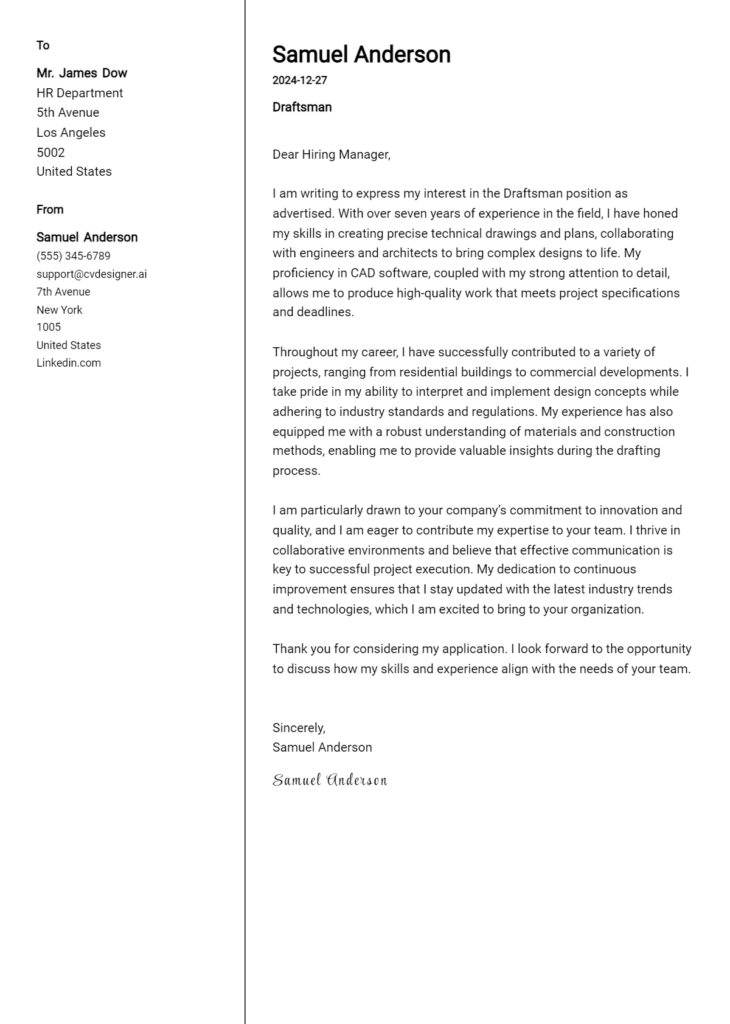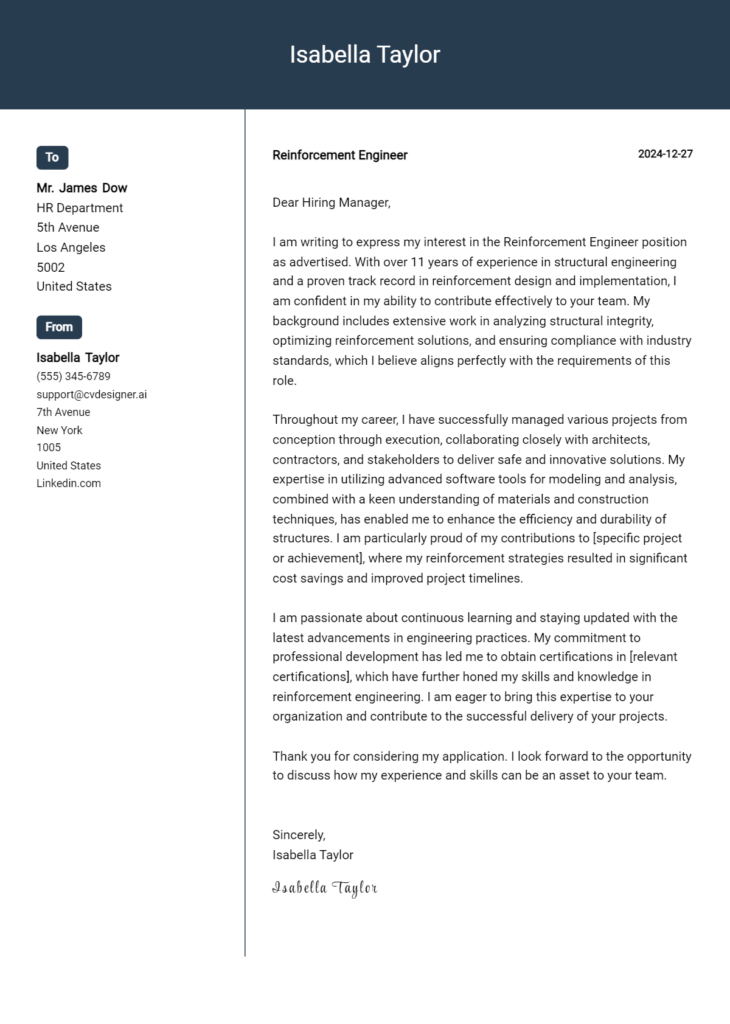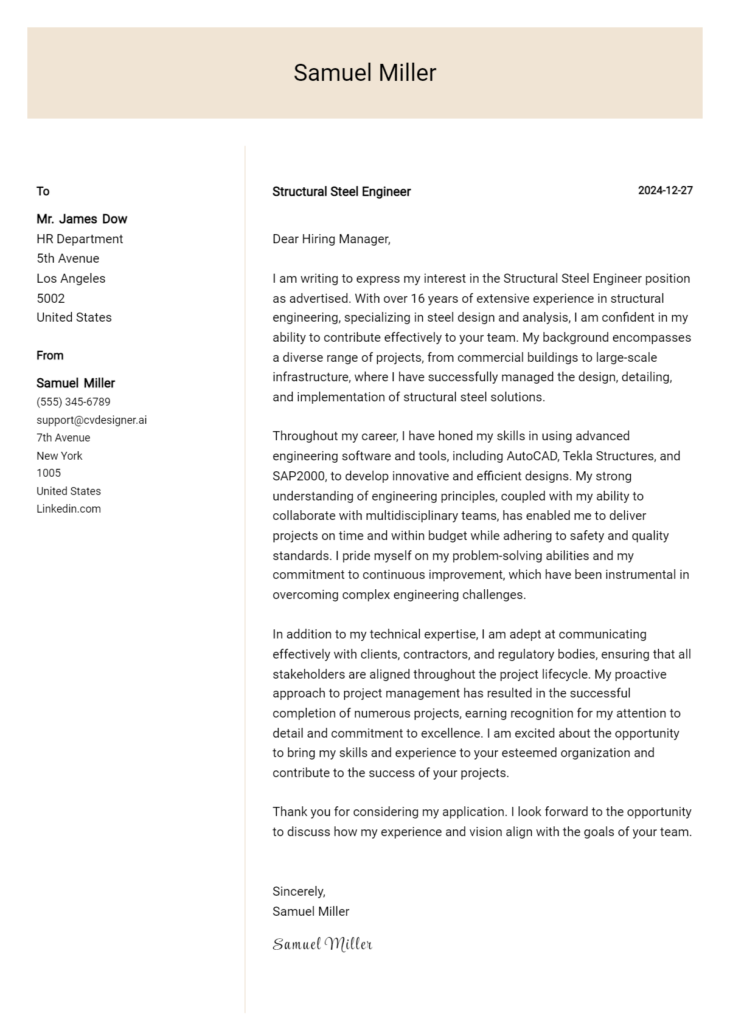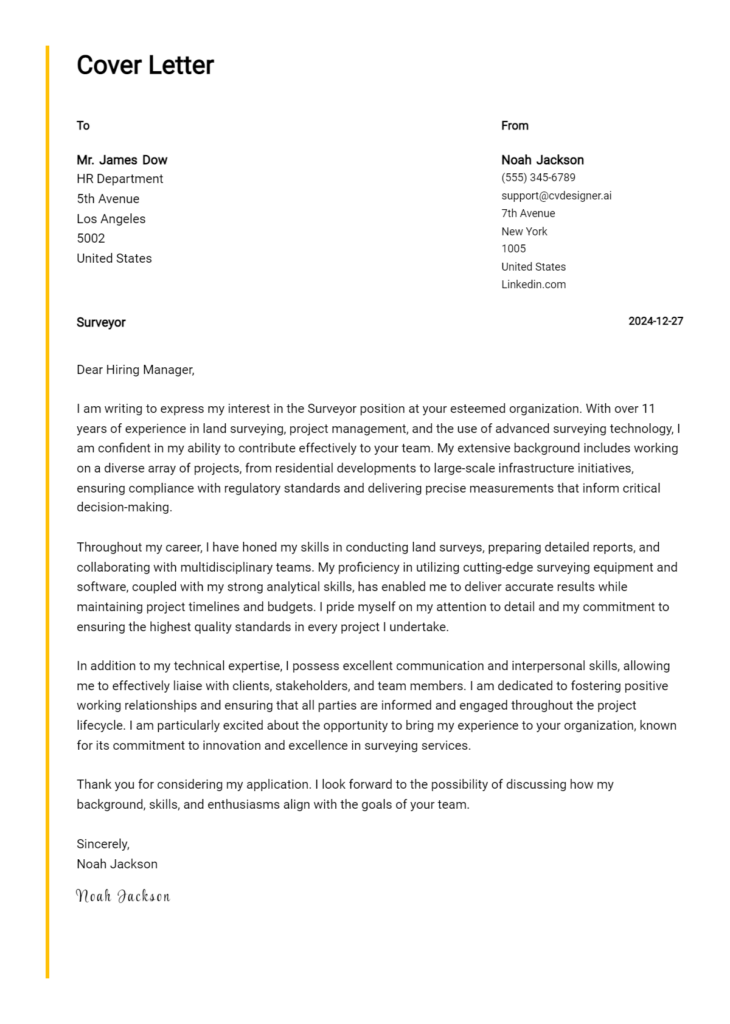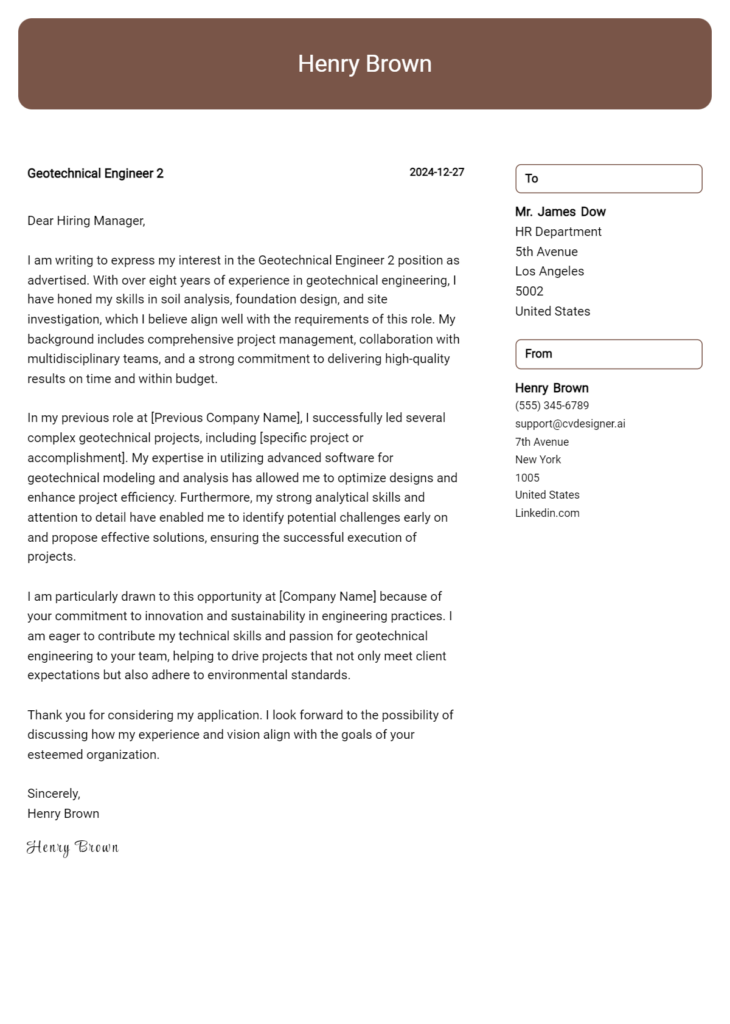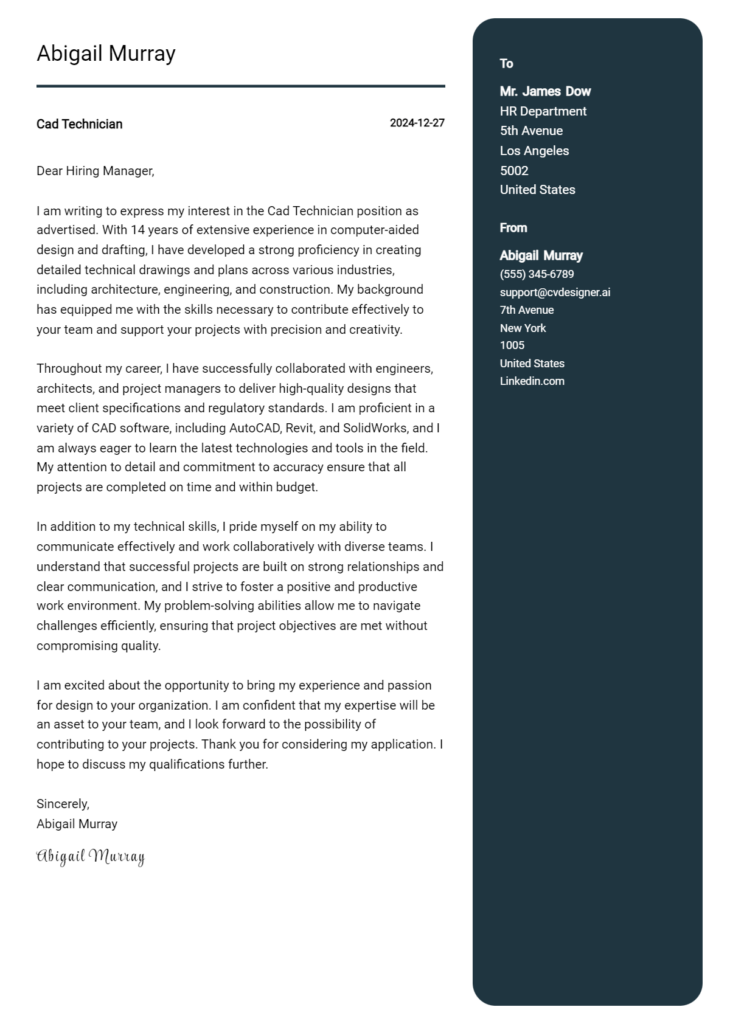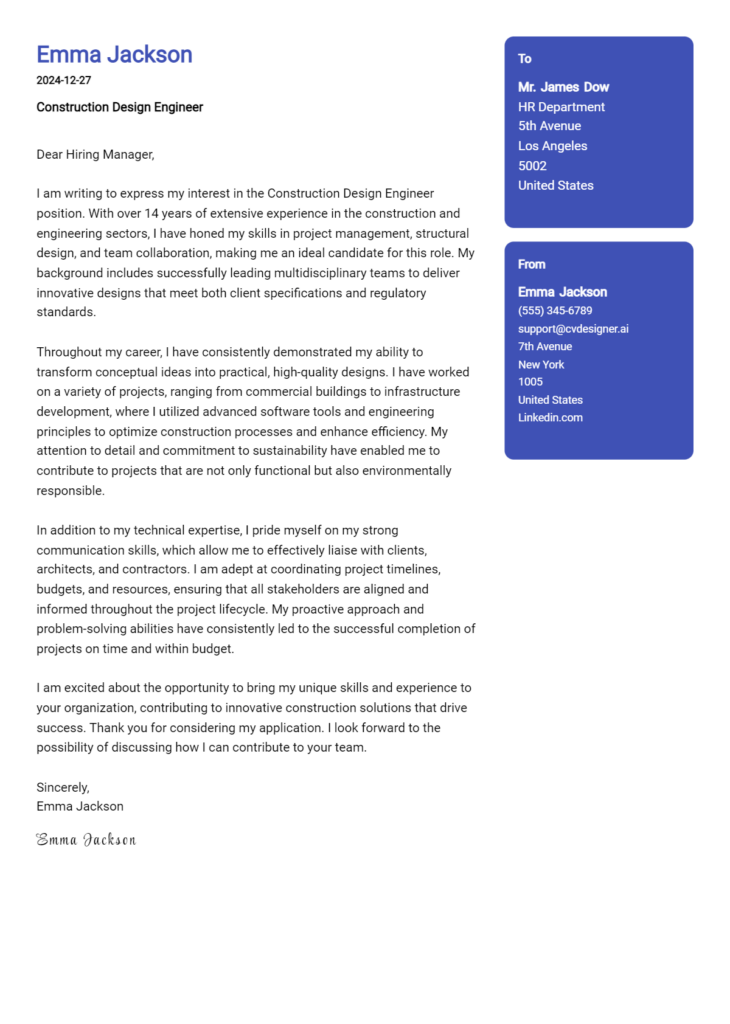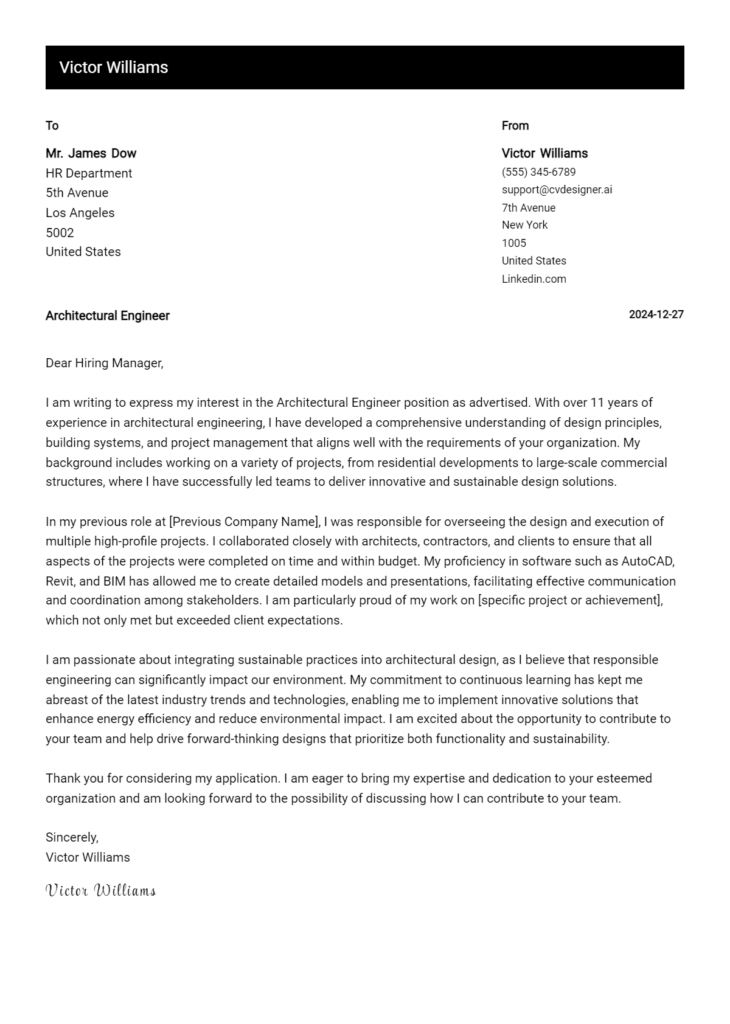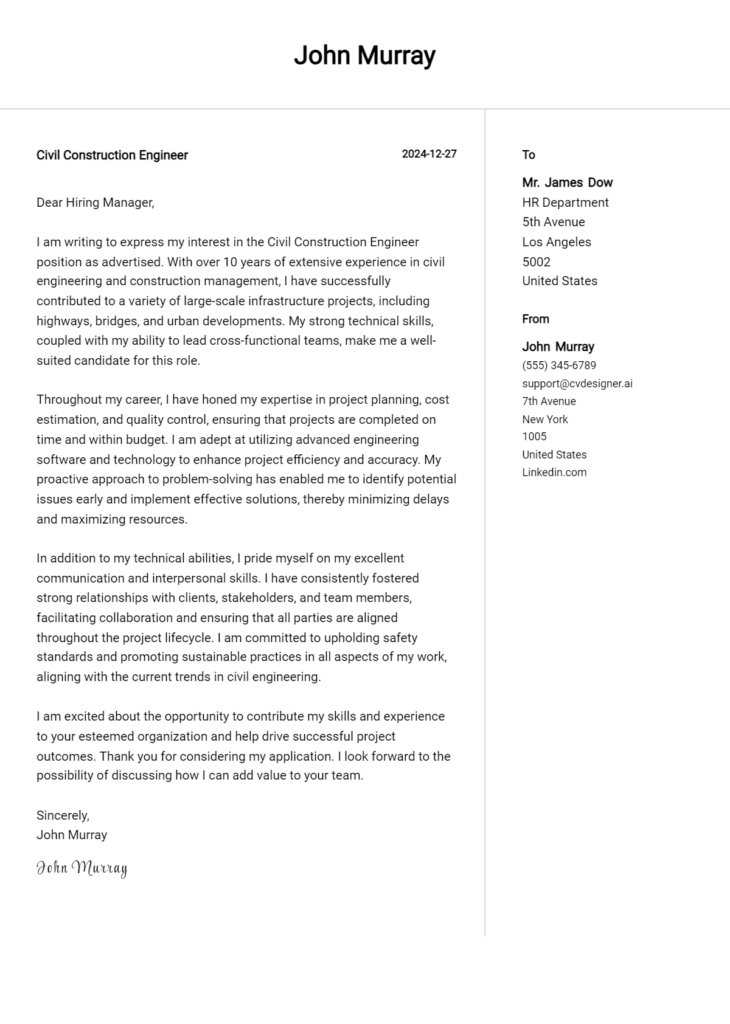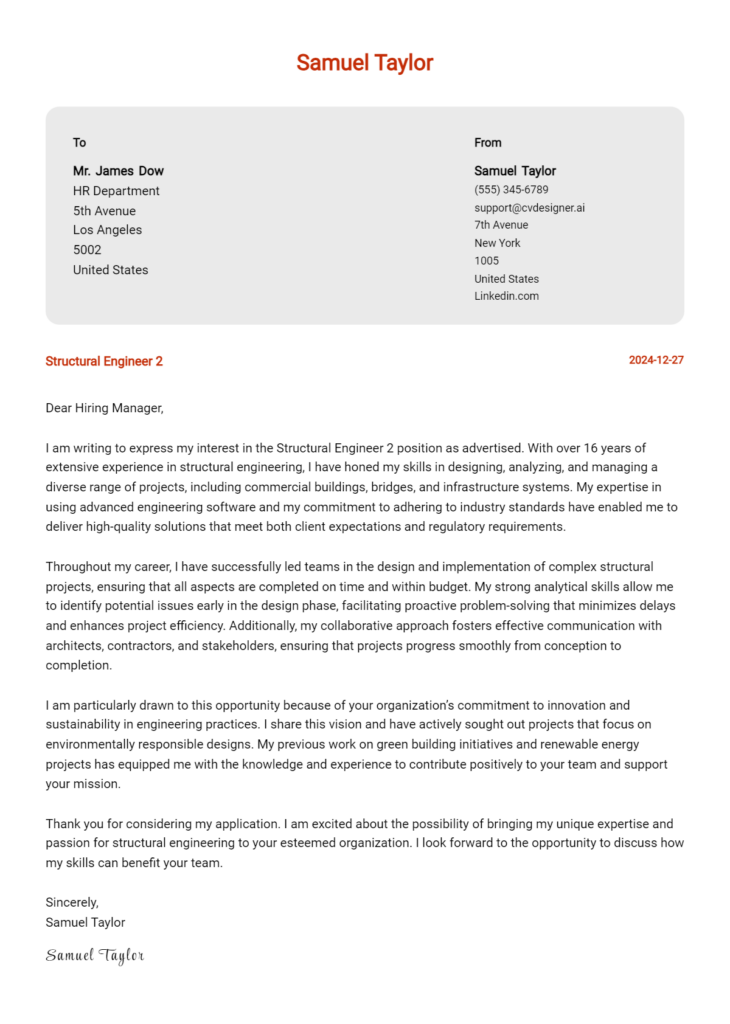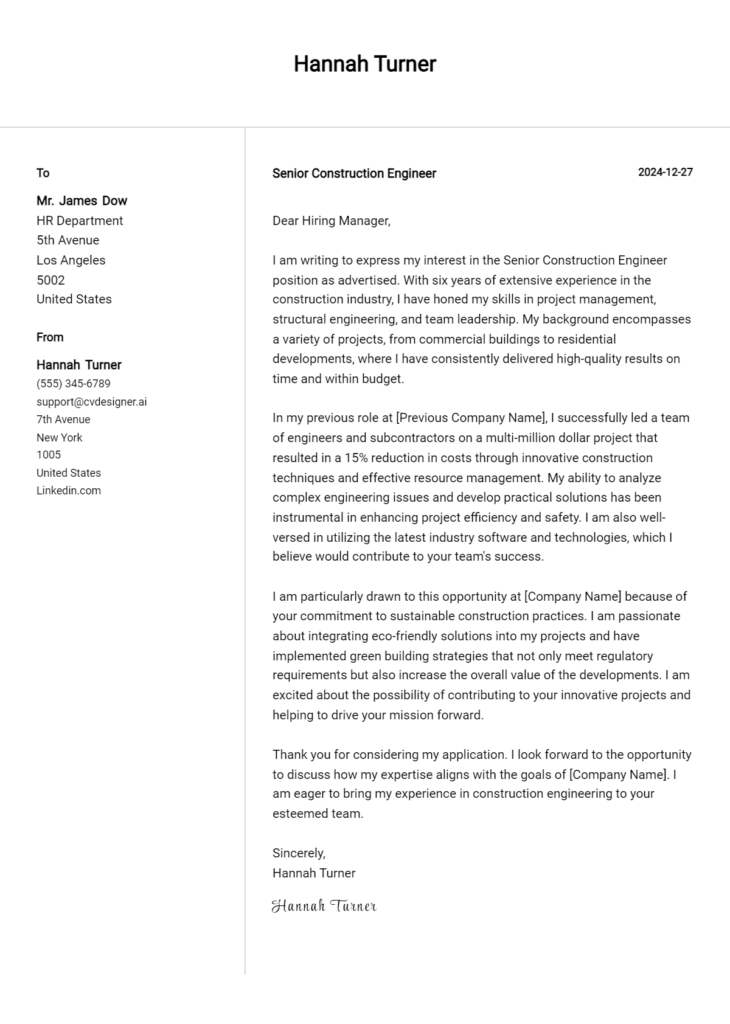Structural Engineer 3 Cover Letter Examples
Explore additional Structural Engineer 3 cover letter samples and guides and see what works for your level of experience or role.
How to Format a Structural Engineer Cover Letter?
Crafting a well-structured cover letter is critical for a Structural Engineer, as it not only showcases your technical skills but also emphasizes your ability to communicate complex ideas clearly and effectively. The formatting of your cover letter is essential in demonstrating your precision, attention to detail, and professionalism—qualities that are paramount in engineering roles. A well-organized letter can significantly enhance your chances of capturing the hiring manager's attention and making a lasting impression.
In this guide, we will delve into the essential components of a professional cover letter, including:
- Cover Letter Header
- Cover Letter Greeting
- Cover Letter Introduction
- Cover Letter Body
- Cover Letter Closing
Each section is crucial for effectively conveying your qualifications and expertise. Let’s break down each part to help you create a standout cover letter tailored for the structural engineering field.
The Importance of a Cover Letter Header for a Structural Engineer
A well-structured cover letter header is crucial for a Structural Engineer as it sets the tone for the entire document and reflects professionalism. The header should include your contact information, the date, and the recipient's details, enabling clear communication and ensuring that your application is easily identifiable. Clarity in the header not only makes a positive first impression but also demonstrates your attention to detail—an essential trait for a structural engineer.
Strong Example
John Doe 123 Engineering Lane Cityville, ST 12345 (123) 456-7890 john.doe@email.com October 1, 2023 Jane Smith Hiring Manager XYZ Engineering Firm 456 Structural Ave Townsville, ST 67890
Weak Example
JD 123 St City, ST 10/1/2023 HR XYZ Firm 456 St
The Importance of a Greeting in a Cover Letter
The greeting of a cover letter is crucial as it sets the tone for the entire document. A well-crafted greeting not only demonstrates your professionalism but also shows that you have personalized your application by addressing the hiring manager directly. This small but significant detail can make a lasting impression, signaling your genuine interest in the position and the company. To avoid generic greetings that may come off as impersonal, it is essential to do your research and find out the name of the hiring manager or the individual responsible for the recruitment process. If their name is not readily available, a thoughtful inquiry or a call to the company can be beneficial.
Below are examples of strong and weak greetings specifically tailored for a Structural Engineer cover letter.
Strong Greeting Example
Dear Mr. Smith,
Weak Greeting Example
To Whom It May Concern,
The Importance of a Compelling Cover Letter Introduction for a Structural Engineer
A well-crafted cover letter introduction is crucial for any Structural Engineer seeking to make a strong impression on a hiring manager. This opening paragraph serves as the first opportunity to capture the reader's attention, express genuine interest in the position, and succinctly highlight key skills or achievements that set the candidate apart. A strong introduction can pique curiosity and encourage the hiring manager to delve deeper into the application, while a weak introduction may lead to a missed opportunity. Below are examples of what makes an introduction effective and what pitfalls to avoid.
Strong Example
Dear [Hiring Manager's Name], I am excited to apply for the Structural Engineer position at [Company Name], as advertised on [Where You Found the Job Posting]. With over five years of experience in designing innovative, safe, and sustainable structures, I have successfully led projects that not only met but exceeded client expectations. My recent work on the [Specific Project Name], which involved complex load calculations and innovative material usage, not only enhanced my technical skills but also reinforced my passion for creating impactful engineering solutions.
Weak Example
To Whom It May Concern, I am writing to apply for the Structural Engineer position. I have some experience in engineering and think I could be a good fit for the job. I am interested in working for your company and hope to hear from you soon.
Purpose of the Cover Letter Body for a Structural Engineer
The body of a cover letter for a Structural Engineer serves as a critical component in presenting a candidate's qualifications, experiences, and the unique value they can bring to a prospective employer. This section allows the applicant to elaborate on specific projects that demonstrate their technical expertise, problem-solving abilities, and successful collaboration with multidisciplinary teams. By highlighting accomplishments such as the design of a landmark building, the successful completion of a complex bridge project, or innovative solutions to structural challenges, the cover letter body can effectively convey the candidate's readiness to contribute to the company's goals and projects.
Strong Example
I am excited to apply for the Structural Engineer position at XYZ Engineering. In my previous role at ABC Construction, I led a project team in the design and execution of a 30-story commercial building, which not only met all safety standards but was also completed three months ahead of schedule. This project required innovative use of materials and close collaboration with architects and contractors, resulting in a structure that has become a local landmark. My commitment to sustainability also drove the integration of energy-efficient systems, earning the project a LEED Gold certification. I am eager to bring my expertise in structural design and project management to XYZ Engineering to help deliver high-quality infrastructure solutions.
Weak Example
I am applying for the Structural Engineer job. I have worked on some projects before. I believe I can do well in this role. I like to work with buildings and bridges. I am a hard worker and I think I would fit in at your company.
Importance of the Cover Letter Closing for a Structural Engineer
The closing paragraph of a cover letter is crucial as it provides an opportunity to summarize your qualifications, reaffirm your enthusiasm for the position, and prompt the hiring manager to take action. A strong closing can leave a lasting impression, encouraging the employer to review your resume and consider you for an interview. In contrast, a weak closing may fail to convey your eagerness and could diminish the overall impact of your application.
Strong Example
Thank you for considering my application for the Structural Engineer position at XYZ Corp. With a solid foundation in structural design and a proven track record of successful project management, I am excited about the opportunity to contribute to your team. I am eager to bring my expertise in innovative engineering solutions and collaboration to your esteemed projects. I look forward to discussing how my skills align with your needs and would appreciate the chance to schedule an interview at your convenience. Thank you again for your time and consideration.
Weak Example
I hope you look at my resume. I think I might be a good fit for the job. Let me know if you want to talk.
Writing a compelling cover letter is crucial for structural engineers looking to make a strong impression on potential employers. This document not only provides an opportunity to highlight your technical expertise and problem-solving skills but also allows you to demonstrate your understanding of the software development life cycle (SDLC), your ability to work collaboratively in a team, and your commitment to continuous learning. The following tips will guide you in crafting an effective cover letter that showcases these essential attributes.
Cover Letter Writing Tips for Structural Engineers
Highlight Your Technical Skills
Clearly outline your technical competencies relevant to structural engineering, such as proficiency in design software (e.g., AutoCAD, STAAD Pro, Revit). Use specific examples of projects where you applied these tools effectively. This will demonstrate your capability to handle the technical aspects of the job.Showcase Problem-Solving Abilities
Employers value engineers who can think critically and solve complex problems. Include a brief anecdote about a challenging project you worked on and how your innovative solutions contributed to its success. This can illustrate your analytical skills and resourcefulness.Demonstrate SDLC Knowledge
If applicable, mention your familiarity with the software development life cycle, especially if you have experience integrating technology into structural engineering processes. Discuss how understanding the SDLC can enhance project efficiency and collaboration with software teams.Emphasize Teamwork and Collaboration
Structural engineering often involves working in multidisciplinary teams. Highlight your experience collaborating with architects, contractors, and other engineers. Mention how your communication skills and ability to work well with others have led to successful project outcomes.Express a Passion for Continuous Learning
The field of structural engineering is constantly evolving, so it’s important to convey your commitment to professional development. You might mention relevant certifications, workshops, or courses you’ve completed recently that demonstrate your desire to stay updated with the latest industry trends and technologies.
Crafting an impactful cover letter can be made easier with the right tools. Consider exploring cover letter templates to get started, or use a cover letter builder to help you create a polished and professional document tailored to your unique qualifications.
Common Mistakes to Avoid in a Structural Engineer Cover Letter
Crafting a compelling cover letter is essential for standing out in a competitive job market, especially for a specialized role like a Structural Engineer. Avoiding common pitfalls can significantly enhance your chances of securing an interview. Here are some frequent mistakes to watch out for:
Generic Language: Using vague or generic phrases can make your cover letter forgettable. Personalize your letter for each application by referencing specific projects or values of the company.
Neglecting Formatting: A poorly formatted cover letter can detract from your professionalism. Ensure you follow a clear cover letter format to maintain readability and structure.
Focusing on Responsibilities Rather than Achievements: Rather than listing job duties, highlight your accomplishments. Quantify your successes where possible to demonstrate your impact.
Ignoring the Job Description: Failing to align your skills with the job requirements can weaken your application. Carefully read the job description and tailor your letter to address the key qualifications.
Overusing Technical Jargon: While it’s important to showcase your expertise, overloading your letter with technical terms can alienate non-technical hiring managers. Strive for a balance between professionalism and accessibility.
Being Too Lengthy: A cover letter should be concise—ideally, no longer than one page. Focus on the most relevant points to keep the reader engaged.
Neglecting Proofreading: Spelling or grammatical errors can give a poor impression. Always proofread your letter or ask someone else to review it before submission.
By steering clear of these mistakes and utilizing effective cover letter examples, you can create a strong impression and enhance your application as a Structural Engineer.
Cover Letter FAQs for Structural Engineer
What should I include in my cover letter as a Structural Engineer?
In your cover letter, start with a strong introduction that captures the hiring manager's attention. Mention the specific position you're applying for and how you learned about the opportunity. Highlight your relevant qualifications, such as your degree in structural engineering and any certifications like PE (Professional Engineer). Discuss your experience with specific types of projects, such as residential, commercial, or industrial structures, and any software proficiency (e.g., AutoCAD, SAP2000). Don’t forget to showcase your problem-solving skills and ability to work collaboratively with architects and contractors. Conclude with a strong closing statement expressing your enthusiasm for the role and your desire for an interview.
How do I tailor my cover letter for a specific job application?
To tailor your cover letter, begin by carefully reading the job description and identifying key requirements and responsibilities. Use this information to highlight your relevant experiences and skills. For instance, if the role emphasizes experience with seismic design, mention specific projects where you’ve applied these principles. Incorporate keywords from the job listing to demonstrate alignment with the company’s needs. Research the company’s recent projects and values, and reference them in your cover letter to show your genuine interest. Finally, customize your closing by expressing how your skills align with the company’s mission, reinforcing your fit for the role.
Should I include my salary expectations in the cover letter?
Typically, it’s best to avoid mentioning salary expectations in your cover letter unless explicitly requested in the job description. The cover letter should focus on showcasing your qualifications, skills, and enthusiasm for the position rather than discussing compensation. Bringing up salary too early in the application process can detract from your value as a candidate and may limit future negotiations. If the employer does request that information, provide a salary range based on market research and your experience level. However, if the topic comes up during an interview, be prepared to discuss your expectations confidently and based on industry standards.
How can I make my cover letter stand out from other applicants?
To make your cover letter stand out, start with a compelling opening that reflects your passion for structural engineering and your specific interest in the company. Use a clear and professional format, ensuring it’s easy to read. Instead of merely listing your qualifications, tell a story that showcases your achievements or challenges you’ve overcome in previous projects. Quantify your accomplishments when possible, such as reducing project costs by a certain percentage or successfully completing a complex design ahead of schedule. Additionally, demonstrate your knowledge of the company’s projects and values, and explain how your personal values align with theirs. End with a confident closing that invites further discussion about your qualifications.
Build your Cover Letter in minutes
Use an AI-powered cover letter builder and have your letter done in 5 minutes. Just select your template and our software will guide you through the process.

